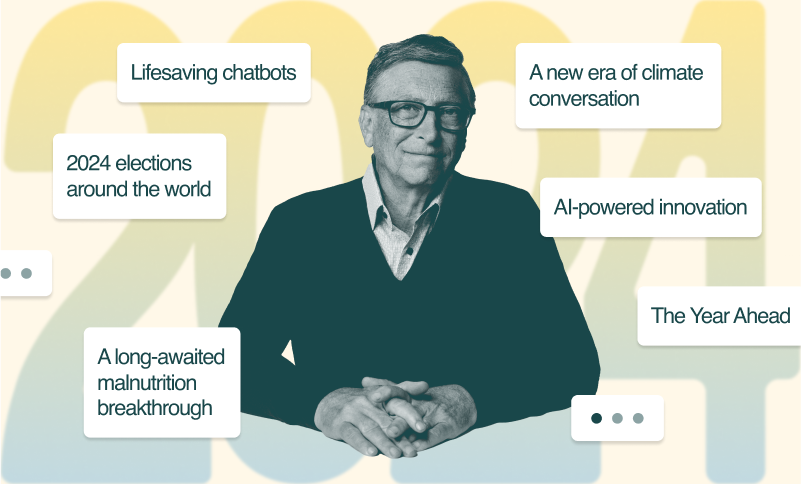Lately, I’ve found myself drawn to the kinds of books I would’ve liked as a kid.
During last year’s campaign, President Joe Biden argued that the “United States must lead the world to take on the existential threat we face—climate change.” I agree. Although COVID-19 will rightfully continue to dominate the agenda, the President and Congress also have the opportunity to lead the world in avoiding a climate disaster.
I’ve learned from my work at Microsoft and in philanthropy that the best way to encourage others to take action is to start by doing it yourself. President Biden has already taken an important first step by rejoining the Paris climate accord. Now the United States can build on that step by adopting a concrete plan that checks several boxes at once: eliminating emissions while adapting to the warming that is already happening, spurring innovative industries, creating jobs for the post-pandemic recovery, and ensuring that everyone benefits from the transition to a green economy. (This plan is a key part of my upcoming book about climate change. And I’ll be writing about the last point—the transition to a green economy—here on the Gates Notes in the next few months.)
In the 15 years that I’ve been learning about and investing in clean energy, I’ve benefited from many discussions with scientists, policy experts, and elected leaders from across the political spectrum, in the United States and around the world. Drawing on those conversations, here are four ways that America and other countries can advance their leadership on climate change this year and put the world on a path to zero emissions by 2050.
1. Increase the supply of innovation.
We need breakthroughs in the way we generate and store clean electricity, grow food, make things, move around, and heat and cool our buildings, so we can do all these things without adding more greenhouse gases to the atmosphere. We have some of the tools we need, like solar and wind power, but far from all of them. And we won’t develop new tools without a dramatic infusion of investment and focus from the federal government.
Just how dramatic? I estimate that federal spending on clean-energy research and development needs to go up fivefold—an increase that would put it on equal footing with health research. And it would be a key first step in creating more than 370,000 jobs as well.
But this is not simply about throwing more money at the problem. We also need to make sure the government is set up to avoid duplication and make the best use of these resources. That’s why we should create the National Institutes of Energy Innovation.
This NIEI should be modeled on the phenomenally successful National Institutes for Health. For example, just like NIH, it would consist of various institutes focused on specific areas. An Institute of Transportation Decarbonization would be responsible for work on low-carbon fuels. Other institutes would have similar responsibilities and authority for research on energy storage, renewables, and so on.
If I could pick just one thing that the U.S. could do to lead the world in technological innovations for clean energy, this would be it.
2. Increase the demand for innovation.
I learned the hard way at Microsoft that simply making a great product doesn’t guarantee that you will beat the competition. Sometimes there’s just not enough demand for what you’re selling.
The lesson for climate change is that we can’t avoid a climate disaster through technological innovation alone. We also need policy innovations to make sure that scientists’ breakthroughs make it from the lab to the market, and that they’re affordable enough for developing countries as well as rich ones.
That means doing things like setting standards for how much electricity or fuel must come from zero-carbon options. Governments can also use their procurement power to create demand for cleaner options—for example, buying only electric buses, as the city of Shenzhen, China has done. They can build the infrastructure that allows for green options: charging stations for electric vehicles, or new transmission lines to deliver clean energy from the places where it’s generated to the places where it’s consumed.
Finally, governments can level the playing field so it’s easier for clean alternatives to compete on price.
The problem is that right now, products that cause emissions aren’t priced to reflect the environmental damage they cause. They should be. Carbon taxes and cap-and-trade programs are two ways to solve this problem.
The idea isn’t to punish people for their greenhouse gases. It’s to create incentives for inventors to create competitive carbon-free alternatives and for consumers to buy them.
3. Work globally.
Climate change is the definition of a global issue. Temperatures won’t stop going up in Texas unless emissions stop going up in India (and temperatures in India won’t stop going up until emissions stop going up in Texas).
That is why governments need to work together to develop common goals, share knowledge, and make sure that clean technologies developed in one country will spread quickly to others. This cooperation can happen on a bilateral basis—between two countries talking directly to each other—as well as among many governments through venues like the United Nations and Mission Innovation.
To see why this is so important, look at the global growth of the nuclear energy industry. Today, most of the world’s nuclear reactors are based on American technology. Why? Because after World War II, the United States led an international effort to develop and deploy this breakthrough energy source. It collaborated on R&D with a range of international partners, making it possible for American firms to license technology to them, export equipment to them, and sell them nuclear fuel. And today, policymakers across the federal government—from the Nuclear Regulatory Commission to the State Department—work together to advance the global deployment of nuclear energy.
We need a similar approach to clean-energy breakthroughs.
4. Prepare for a warming world.
We’re already seeing the impact of climate change. So even as we develop and deploy ways to prevent future warming, we also need to adapt to the effects that higher temperatures are having around the world.
Countries will need to invest in climate-proofing infrastructure to cope with more severe weather and rising sea levels. This includes upgrading electrical grids, expanding storm water drainage systems, and building or expanding seawalls. And two of the best ways for wealthy countries to help low- and middle-income ones is to invest in primary health care and make sure smallholder farmers can grow enough food to feed everyone.
The Global Commission on Adaptation, which I co-chair along with Ban Ki-Moon and Kristalina Georgieva, has published a number of evidence-based recommendations. I encourage you to check out the commission’s work.
To be sure, governments aren’t the only ones who need to act across all four areas. Businesses, philanthropists, and individuals can also play a pivotal role by advocating for these policies, investing in low-emissions solutions, paying the Green Premiums when they can, and more. I’ll be writing more about these areas in future posts, and they’re covered in How to Avoid a Climate Disaster as well.
I see promise in 2021. The next major U.N. Summit on climate change—to be hosted by the United Kingdom in November—is an opportunity for countries around the world, including the U.S., to showcase their leadership on this urgent problem. If they want to lead by doing, the four steps laid out here are a good place to start.





